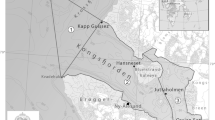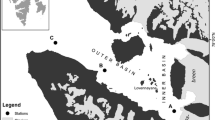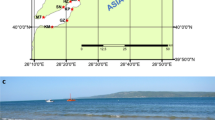Abstract
This study deals with meiofauna associated with a sublittoral population of the kelp Laminaria ochroleuca located on the northern coast of Spain. By sampling once a year over a 4-year period, we examined patterns of faunal distribution as a function of some environmental factors at the meso-scale level (depth, and exposure to waves and surge). We also examined the relationship between L. ochroleuca abundance (as dry weight biomass and number of plants per sampling quadrat) and abundance and diversity of meiofauna. Finally, we investigated patterns of within-plant distribution (algal frond vs. algal holdfast), using also the meiofauna of the adjacent bottom as a referent to estimate the level of "phytal dependence" of the meiofauna collected on L. ochroleuca. We found that the bulk of permanent meiofauna consisted of nematodes, copepods, mites, polychaetes, tanaids and ostracods, with copepods being predominant on the fronds of the alga and nematodes in the holdfasts. The temporary meiofauna consisted of juvenile amphipods, bivalves and gastropods, together with barnacle nauplii and cyprids. Abundance and major composition of meiofaunal taxa were unrelated to both depth and hydrodynamic exposure of the sampling quadrats. However, we detected significant qualitative and quantitative faunal differences as a function of microhabitat. All meiofaunal groups were more abundant in holdfast samples than in frond and bottom samples. The gross taxonomic composition of meiofauna in bottom samples was similar to that in holdfast samples, but substantially different from that of meiofauna associated with the fronds. The L. ochroleuca holdfasts, in which dense aggregations of meiofauna can occur, appear to function as ecotone between phytal and rocky-bottom microhabitats. All together, our results suggest that the distribution of meiofauna within the Laminaria bed is mostly affected by factors operating at the microhabitat level rather than the meso-scale level.







Similar content being viewed by others
References
Allen JC, Griffiths CL (1981) The fauna and flora of a kelp bed canopy. S Afr J Zool 16:80–84
Arroyo NL (2002) Meiofauna asociada al alga Laminaria ochroleuca de la Pylaie en la isla de Mouro (Santander, Cantabria). PhD thesis, Universidad Complutense de Madrid, Madrid
Atilla N, Fleeger JW (2000) Meiofaunal colonization of artificial substrates in an estuarine embayment. Mar Ecol 21:69–83
Bell SS, Walters K, Hall MO (1987) Habitat utilization by harpacticoid copepods: a morphometric approach. Mar Ecol Prog Ser 35:59–64
Braud JP (1974) Etude de quelques parametres ecologiques, biologiques et biochimiques chez une pheophycee des cotes Bretonnes. Laminaria ochroleuca. Revue Trav Inst (Sci Tech) Pêch Marit 38:115–204
Carlucci MJ, Scolaro LA, Errea MI, Matulewicz MC, Damonte EB (1997) Antiviral activity of natural sulphated galactans on herpes virus multiplication in cell culture. Planta Med 63:429–432
Clarke KR (1993) Non-parametric multivariate analyses of changes in community structure. Aust J Ecol 18:117–143
Colman J (1940) On the faunas inhabiting intertidal seaweeds. J Mar Biol Assoc UK 24:129–183
Coull BC, Creed EL, Eskin RA, Montagna PA, Palmer MA, Wells JBJ (1983) Phytal meiofauna from the rocky intertidal at Murretts Inlet, South Carolina. Trans Am Microsc Soc 102:380–389
Dahl E (1948) On the smaller Arthropoda of marine algae, especially in the polyhaline waters off the Swedish west coast. Dissertation, Lund. Undersökningar över Öresund 35:1–193
De Troch M, Gurdbeke S, Friers F, Vincx M (2001) Zonation and structuring factors of meiofauna communities in a tropical seagrass bed (Gazi Bay, Kenya). J Sea Res 45:45–61
Edgar GJ (1983a) The ecology of south-east Tasmanian phytal animal communities. I. Spatial organization on a local scale. J Exp Mar Biol Ecol 70:129–157
Edgar GJ (1983b) The ecology of south-east Tasmanian phytal animal communities. II. Seasonal change in plant and animal populations. J Exp Mar Biol Ecol 70:159–179
Edgar GJ (1983c) The ecology of south-east Tasmanian phytal animal communities. III. Patterns of species diversity. J Exp Mar Biol Ecol 70:181–203
Edgar GJ (1990) The influence of plant structure on the species richness, biomass and secondary production of macrofaunal assemblages associated with Western Australian seagrass beds. J Exp Mar Biol Ecol 137:215–240
Fenwick GD (1976) The effect of wave exposure on the amphipod fauna of the alga Caulerpa brownii. J Exp Mar Biol Ecol 25:1–18
García-Castrillo G, Rodríguez C, Puente A, Preciado I, Serrano A, Juanes J (2000a) Cartografiado bentónico sublitoral de la Isla de Mouro (Cantabria). Ozeanografika 3:69–83
García-Castrillo G, Serrano A, Preciado I, Rodríguez C, Puente A, Juanes J (2000b) Estructuración biocenótica de la comunidad de laminariales de la Isla de Mouro (Mar Cantábrico, Santander). Ozeanografika 3:85–99
Gee JM, Warwick RM (1994a) Metazoan community structure in relation to the fractal dimensions of marine macroalgae. Mar Ecol Prog Ser 103:141–150
Gee JM, Warwick RM (1994b) Body-size distribution in a marine metazoan community and the fractal dimensions of macroalgae. J Exp Mar Biol Ecol 178:247–259
Gibbons MJ (1988a) The impact of wave exposure on the meiofauna of Gelidium pristoides (Turner) Kuetzing (Gelidiales: Rhodophyta). Estuar Coast Shelf Sci 27:581–593
Gibbons MJ (1988b) The impact of sediment accumulations, relative habitat complexity and elevation on rocky shore meiofauna. J Exp Mar Biol Ecol 122:225–241
Gibbons MJ, Griffiths CL (1986) A comparison of macrofaunal and meiofaunal distribution and standing stock across a rocky shore, with an estimate of their productivities. Mar Biol 93:181–188
Gunnill FC (1982a) Macroalgae as habitat patch islands for Scutellidium lamellipes (Copepoda: Harpacticoida) and Amphitoe tea (Amphipoda: Gammaridae). Mar Biol 69:103–116
Gunnill FC (1982b) Effects of plant size and distribution on the numbers of invertebrate species and individuals inhabiting the brown alga Pelvetia fastigiata. Mar Biol 69:263–280
Gunnill FC (1983) Seasonal variations in the invertebrate faunas of Pelvetia fastigiata (Fucaceae): effects of plant size and distribution. Mar Biol 73:115–130
Hagerman L (1966) The macro- and microfauna associated with Fucus serratus L., with some ecological remarks. Ophelia 3:1–43
Hall MO, Bell SS (1988) Response of small motile epifauna to complexity of epiphytic algae on seagrass blades. J Mar Res 46:613–630
Heck KL, Wetstone GS (1977) Habitat complexity and invertebrate species richness and abundance in tropical seagrass meadows. J Biogeogr 4:135–142
Hicks GRF (1977a) Species composition and zoogeography of marine phytal harpacticoid copepods from Cook Strait, and their contribution to total phytal meiofauna. NZ J Mar Freshw Res 11:441–469
Hicks GRF (1977b) Species associations and seasonal population densities of marine phytal harpacticoid copepods from Cook Strait. NZ J Mar Freshw Res 11:621–643
Hicks GRF (1980) Structure of phytal harpacticoid copepod assemblages and the influence of habitat complexity and turbidity. J Exp Mar Biol Ecol 44:157–192
Hicks GRF (1985) Meiofauna associated with rocky shore algae. In: Moore PG, Seed R (eds) The ecology of rocky coasts. Hodder and Stoughton, London
Hicks GRF, Grahame J (1979) Mucus production and its role in the feeding behaviour of Diarthrodes nobilis (Copepoda: Harpacticoida). J Mar Biol Assoc UK 59:321–330
Hornsey IS, Hide D (1976) The production of antimicrobial compounds by British marine algae. II. Seasonal variation in production of antibiotics. Br Phycol J 11:63–67
Hull SL (1997) Seasonal changes in diversity and abundance of ostracods on four species of intertidal algae with differing structural complexity. Mar Ecol Prog Ser 161:71–82
Jarvis SC, Seed R (1996) The meiofauna of Ascophyllum nodosum (L.) Le Jolis: characterization of the assemblages asociated with two common epiphytes. J Exp Mar Biol Ecol 199:249–267
John DM (1969) An ecological study on Laminaria ochroleuca. J Mar Biol Assoc UK 49:175–187
Johnson SC, Scheibling RE (1987) Structure and dynamics of epifaunal assemblages on interidal macroalgae Ascophyllum nodosum and Fucus vesiculosus in Nova Scotia, Canada. Mar Ecol Prog Ser 37:209–227
Kain JM (1979) A view of the genus Laminaria. Oceanogr Mar Biol Annu Rev 17:101–161
Kangas P (1978) On the quality of meiofauna among the epiphytes of Fucus vesiculosus in the Asko area, northern Baltic Sea. Contrib Asko Lab, Univ Stockholm 24:1–32
Lippert H, Iken K, Rachor E, Wiencke C (2001) Macrofauna associated with macroalgae in the Kongsfjord (Spitsbergen). Polar Biol 24:512–522
McKenzie JD, Moore PG (1981) The microdistribution of animals associated with the bulbous holdfasts of Saccorhiza polyschides (Phaeophyta). Ophelia 20:201–213
McIntyre AD (1969) Ecology of marine meiobenthos. Biol Rev 44:245–290
Moore PG (1971) The nematode fauna associated with holdfasts of kelp (Laminaria hyperborea) in N.E. Britain. J Exp Mar Biol Assoc UK 51:589–604
Moore PG (1972a) Particulate matter in the sublittoral zone of an exposed coast and its ecological significance with special reference to the fauna inhabiting kelp holdfasts. J Exp Mar Biol Ecol 10:59–80
Moore PG (1972b) The kelp fauna of northeast Britain. I. Introduction and the physical environment. J Exp Mar Biol Ecol 13:97–125
Moore PG (1973) The kelp fauna of northeast Britain. II Multivariate classification: turbidity as an ecological factor. J Exp Mar Biol Ecol 13:127–163
Moore PG (1978) Turbidity and kelp holdfasts. Amphipoda. 1. Wales and S.W. England. J Exp Mar Biol Ecol 32:53–96
Norton TA (1971) An ecological study of the fauna inhabiting the sublittoral marine alga Saccorhiza polyschides (Lightf.) Batt. Hydrobiologia 37:215–231
Novak R (1982) Spatial and seasonal distribution of the meiofauna in the seagrass Posidonia oceanica. Neth J Sea Res 16:380–388
Pallares RE, Hall MA (1974) Análisis bioestadístico-ecológico de la fauna de copépodos asociados a los bosques de Macrocystis pyrifera (Conclusion). Physis (B Aires) 33:409–432
Prathep A, Marrs RH, Norton TA (2003) Spatial and temporal variations in sediment accumulation in an algal turf and their impact on associated fauna. Mar Biol 142:381–390
Preston A, Moore PG (1988) The flora and fauna associated with Cladophora albida (Huds.) Küntz. from rockpools on Great Cumbrae Island, Scotland. Ophelia 29:169–186
Puente A (2000) Distribución y estructura de las comunidades de macroalgas de la Isla de Mouro (Cantabria, Golfo de Vizcaya). Consideraciones sobre su aplicación en la vigilancia ambiental de espacios litorales. PhD thesis, Universidad de Cantabria, Santander
Pugh PJA, King PE (1985) Vertical distribution and substrate association of the British Halacaridae. J Nat Hist 19:961–968
Quinn GP, Keough MJ (2002) Experimental design and data analysis for biologists. Cambridge University Press, Cambridge
Sánchez-Jerez P, Barberá Cebrián C, Ramos Esplá A (1999) Comparison of the epifauna spatial distribution in Posidonia oceanica, Cymodocea nodosa and unvegetated bottoms: importance of meadow edges. Acta Oecol 20:391–405
Sarma ALN, Ganapati PN (1972) Faunal associations of algae in the intertidal region of Visakhapatnam. Proc Indian Natl Sci Acad Part B Biol Sci 38:380–396
Schültze K, Janke K, Krüb A, Weidemann W (1990) The macrofauna and macroflora associated with Laminaria digitata and L. hyperborea at the island of Helgoland (German Bight, North Sea). Helgol Meeresunter 44:39–51
Seoane-Camba J (1966) Las laminariáceas de España y su distribución. Publ Tec Junta Estud Pesca 5:425–436
Sheppard CRC (1976) The holdfast ecosystem of Laminaria hyperborea (Gunn.) Fosl. and environmental monitoring: an ecological study. PhD thesis, Durham University, Durham, England
Somerfield PJ, Jeal F (1996) The distribution of Halacaridae (Acari: Prostigmata) among macroalgae on sheltered rocky shores. J Mar Biol Assoc UK 76:251–254
Tzetlin AB, Mokievsky VO, Melnikov AN, Saphonov MV, Simdyanov TG, Ivanov IE (1997) Fauna associated with detached kelp in different types of subtidal habitats of the White Sea. Hydrobiologia 355:91–100
Velmirov B, Field JG, Griffiths CL, Zoutendyk P (1977) The ecology of kelp bed communities in the Benguela upwelling system. Helgol Wiss Meeresunter 30:495–518
Viejo RM (1999) Mobile epifauna inhabiting the invasive Sargassum muticum and two local seaweeds in northern Spain. Aquat Bot 64:131–149
Whatley RC, Wall DR (1975) The relationship between Ostracoda and algae in littoral and sublittoral marine environments. In: Swain FM (ed) Biology and palaeobiology of Ostracoda. Bull Am Palaeontol Soc 65:173–203
Wieser W (1952) Investigations on the microfauna inhabiting seaweeds on rocky coasts. IV. Studies on the vertical distribution of the fauna inhabiting seaweeds below the Plymouth Laboratory. J Mar Biol Assoc UK 31:145–174
Young DK, Young MW (1977) Community structure of the macrobenthos associated with seagrass of the Indian River Estuary, Florida. In: Coull BC (ed) Ecology of marine benthos. University of South Carolina Press, Columbia
Acknowledgements
We are indebted to Dr. G. García-Castrillo for extending the scope of his grant to the meiobenthic domain. We thank the staff of ACEM for their help during sampling, A. Puente for her advice when dealing with seaweed, and I. Preciado for always being there when whatever information was needed. This study was carried out within the framework of two research projects developed by ACEM and funded by the Marcelino Botín Foundation. The study was also partially funded by two grants from the Spanish government (MEC-PB98-0485 and BOS 2000-0568, respectively) and a PhD fellowship from the Universidad Complutense of Madrid to N.L. Arroyo. M. Gibbons and K. Aarnio gave valuable comments on an earlier version of the manuscript. E. Ólafsson and two anonymous referees also provided helpful comments to improve the style and contents of the manuscript.
Author information
Authors and Affiliations
Corresponding author
Additional information
Communicated by L. Hagerman, Helsingør
Rights and permissions
About this article
Cite this article
Arroyo, N.L., Maldonado, M., Pérez-Portela, R. et al. Distribution patterns of meiofauna associated with a sublittoral Laminaria bed in the Cantabrian Sea (north-eastern Atlantic). Marine Biology 144, 231–242 (2004). https://doi.org/10.1007/s00227-003-1191-8
Received:
Accepted:
Published:
Issue Date:
DOI: https://doi.org/10.1007/s00227-003-1191-8




